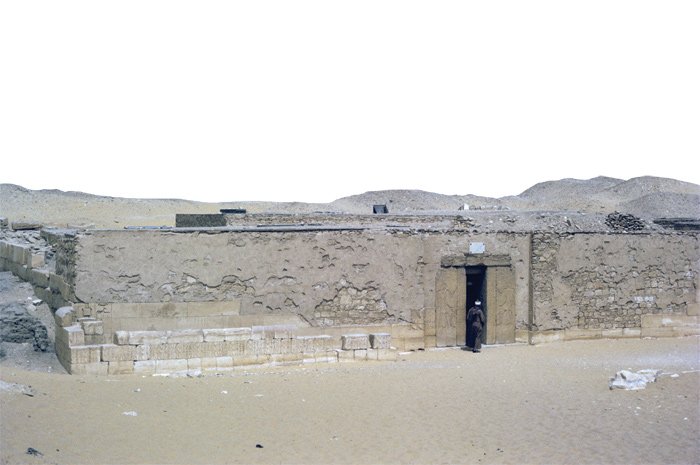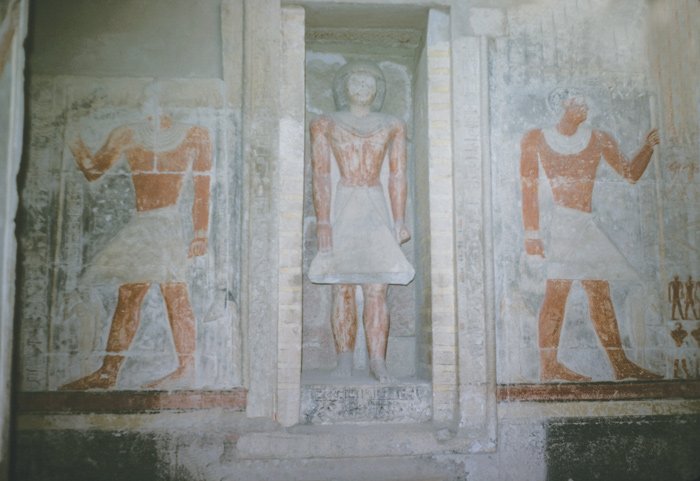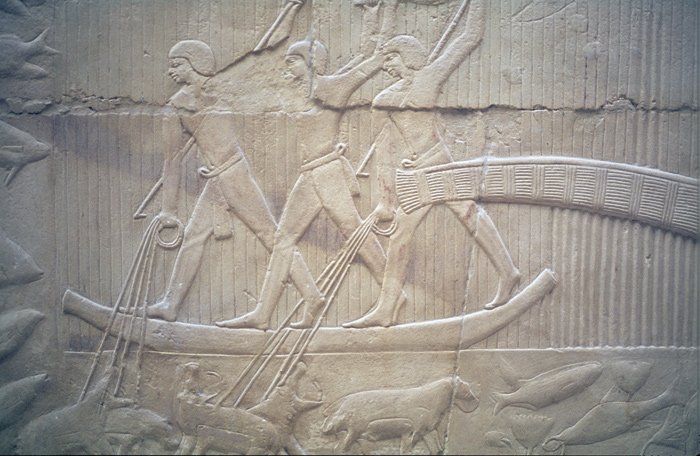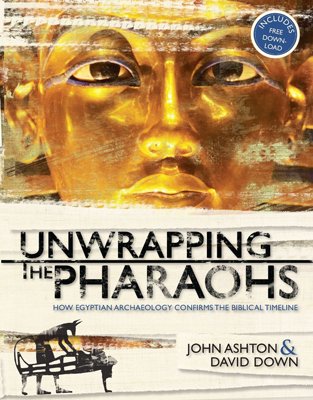
Chapter 9
More Shoddy Pyramids
To the northeast of the massive Step Pyramid of Saqqara is the mastaba of Mereruka, vizier of King Teti of the 6th Dynasty.
Teti was the first king of the 6th Dynasty, and he seems to have been the son of Unas, so why he is recognized as the founder of a new dynasty is hard to say. Professor Kanawati of Macquarie University in Sydney has been excavating at Saqqara for many years and unearthed a mastaba with the inevitable false door. He knew that the tomb shaft would be just before or behind the false door, so he gave orders to his workmen to start digging in front of the door and they would find the tomb shaft. They dug and, sure enough, there was the shaft.

Waiters depicted on the walls of the mastaba of Mereruka bring delicacies to the official’s table. Such scenes on the walls of mastabas in these dynasties give vivid but practical images of life in Egypt at this time, enabling us to picture life as it was.
To the northeast of the massive Step Pyramid of Saqqara is the mastaba of Mereruka, vizier of King Teti of the 6th Dynasty. Dr. Kanawati also excavated the tomb of Mereruka’s mother, which is not far from Mereruka’s mastaba as well as the tomb of some other officials of this dynasty. This latter finding has possibly shed some light on an ancient mystery, which we will relate here.
The Egyptian priest Manetho, who lived in the 3rd century B.C., wrote a history of Egypt, its dynasties, and kings. In it he wrote, “The 6th Dynasty consisted of six kings of Memphis; Othoes [now identified as Teti] for 30 years. He was murdered by his bodyguard.”
Terse and dramatic, it spelled the tragic end to his 30-year reign, but was this really factual history? After all, Manetho lived some 1,500 years after it all happened. Could he be sure of his facts, or was he just repeating a spicy legend about this unfortunate king? Dr. Kanawati believes he has some good circumstantial evidence to prove that Teti was indeed murdered by his bodyguard.
Among the tombs that he excavated were a number of tombs in which some of Teti’s bodyguards were buried. He found that one had a relief of the occupant, showing that his nose had been cut off. That is the sort of humiliating punishment that was meted out to guilty criminals in those days. After all, who wants to be seen in the streets with a gaping hole where his nose ought to be? Also, his feet had been cut off, another humiliating punishment for his afterlife.
Worse than the actual loss of his nose in this life was the prospect of existing forever with no nose. To the Egyptians, the tomb was not a tomb. Dr. Kanawati said that he could not find a word in the hieroglyphs which meant “tomb.” Where they were buried were considered to be palaces. To them a tomb was a house for eternity. They had an unshakable concept of life after death, and the places where they were buried were the eternal palaces where they would live forever, and the wall paintings and reliefs in their tombs depicted scenes which would spring to life after they died, so if this unfortunate man was shown without a nose, that meant that forever and forever he would live without a nose.
There was another piece of convincing evidence. The names of these bodyguards had been carefully erased from their tomb walls. This was not just vandalism. Other writing remained—just their names had been meticulously chiseled out. To an Egyptian, that meant that he would not exist in the afterlife. Forever, he was excluded from the land of the living. So what was the purpose of this spiteful behavior on the part of those who perpetrated these acts? Dr. Kanawati speculates that Teti had indeed been assassinated by his bodyguards, as Manetho recorded, and this was the retribution that had been heaped on the culprits by Teti’s successors. It is true that Manetho lived 1,500 years after all this happened, but he was 2,300 years nearer the scene than we are today—in other words, halfway between Teti and our day, so we can’t dismiss him too lightly.
Actually, the king had to be very careful about choosing his retainers. There were some officials in an even better position to assassinate the king than his bodyguards. The Egyptians were clean-shaven, and the king’s barber would hold a knife near his throat every day. His physician could easily administer a fatal dose of poison, and even his sandal bearer could be a threat. He stood behind the king holding his sandals and would be in a splendid position to stab the king in the back.
A unique feature of Dynasties 5 and 6 was the wealth and status of some of the nobles in this era. They have left behind some costly and exquisite mastabas, on the walls of which are an extraordinary number of reliefs depicting everyday life in Egypt at that time. These have been invaluable to archaeologists who have gained a splendid idea of how Egyptians lived and worked long ago.
For example, near the Serapeum at Saqqara is the tomb of Ti, overseer of the sun temples of Neferikare and Nyusare, during the 5th Dynasty and the mastaba of Mereruka, vizier to the pharaoh Teti. The reliefs on these tombs portray the nobles enjoying hunting, fowling, fishing, and feasting. It seems that to the minds of these ancient people, everything that was shown on their tomb walls would all be animated in the afterlife for their enjoyment. So, there are scenes of cows being slaughtered and prepared for a banquet, bowls of fruit and fat ducks, and acrobats and dancers performing for their enjoyment. In case there was something the tomb owner had omitted from his scenes for the future life, a carpenter is shown doing his work. He could have been commissioned to make the things the tomb owner would need hereafter.
Not far from the pyramid of Unas, the last pharaoh of Dynasty 5, is the mastaba of his daughter, Princess Idut, which has some very unusual reliefs on the walls. One shows a hippopotamus underwater in the act of giving birth to a baby hippo, and just behind the mother is a crocodile with its mouth open waiting to devour the baby hippo as it is born. Why the princess or her family should wish to choose such a pictorial scene in a tomb is hard to understand, but then there are many things about the thinking of the ancient Egyptians that are hard to understand.
Perhaps the most prominent kings in Dynasty 6 were Pepi I and Pepi II. The former is noted for his remarkable life-size statue made of copper, which is still in very good condition with only a small section in the middle missing. Beside it was a smaller copper statue of one of his sons. Another statue shows him kneeling and making votive offerings to the gods, and in this statue there is no question that a smile plays around his lips. Pepi II is well known because he was reportedly the longest-ruling pharaoh. He was on the throne for 92 years. However, not much remains of their pyramids.
According to Manetho, the last ruler of Dynasty 6 was a woman, Nitocris. As far as we know, she would be the first female pharaoh, and Manetho spoke in glowing terms of her beauty. Of course, Manetho had never seen her or a picture of her, but he must have possessed some manuscripts or known of some legend that told of her charms. He wrote, “There was a queen Nitocris, braver than all men of her time, the most beautiful of all the women, fair-skinned with red cheeks. By her, it is said, the third pyramid was reared with the aspect of a mountain.” Herodotus also writes of her being the last ruler of Dynasty 5.
Nitocris was the beautiful and virtuous wife and sister of King Metesouphis II, an Old Kingdom monarch who had ascended to the throne at the end of the 6th Dynasty but who had been savagely murdered by his subjects soon afterwards. Nitocris then became the sole ruler of Egypt and determined to avenge the death of her beloved husband-brother. She gave orders for the secret construction of a huge underground hall connected to the river Nile by a hidden channel. When this chamber was complete she threw a splendid inaugural banquet, inviting as guests all those whom she held personally responsible for the death of the king. While the unsuspecting guests were feasting she commanded that the secret conduit be opened and, as the Nile waters flooded in, all the traitors were drowned. In order to escape the vengeance of the Egyptian people she then committed suicide by throwing herself into a great chamber filled with hot ashes and suffocating.1
If the above account is accurate, then it may in part explain why no tomb for Nitocris has been found and why there appears to have been a confusion of dynasties immediately following her death and the death of the other drowned nobles. Manetho’s Dynasties 7 to 11 suggest that Egypt was in a state of anarchy. Dozens of kings followed each other in quick succession, and the national economy was in a shambles. In fact, one record of Manetho says, “The 7th Dynasty consisted of seventy kings of Memphis who reigned for 70 days.”2 How many kings were in Dynasty 11 is debatable, but at least it included Intef I, who was the founder of the 11th Dynasty and who made Thebes the capital of Egypt, and ended with Mentuhotep III. The Intefs came from Qena, a city on the bend of the Nile north of Luxor, and they built their tombs on the west bank, opposite Karnak. Mentuhotep erected an impressive mortuary temple on the west bank at Luxor, and he left a statue of himself representing him in a state of death, as indicated by his black face.
Some scholars have questioned the existence of some of these dynasties, at least as independent rulers. Scholars refer to this era as the “First Intermediate Period.” However, Courville suggests that it should be identified with the Second Intermediate Period, Dynasties 14 to 16.3 The problem is that only one tomb has been found for the pharaohs of this period, and we are very much in the dark about what really happened; but if these dynasties did not exist independently, the dates of the earlier dynasties would have to be reduced.
Unwrapping the Pharaohs
Adults and children alike are fascinated by Egyptian civilization. But most modern archaeologists have lately tried to use Egyptian chronology to dispute the biblical record. Secular textbooks and videos challenge the faith of students and discredit the biblical account of Exodus. Those who wish to defend the accuracy of the Bible now have an incredible tool in this exciting book that provides compelling confirmation of the biblical account.
Read Online Buy BookFootnotes
- Herodotus, The Histories, p. 166.
- W.G. Waddell (translator), History of Egypt and Other Works by Manetho: The Aegyptiaca of Manetho (Boston, MA: Harvard University Press, 1940), Agyptea (Epitome) Fr 23, p. 57.
- D.A. Courville, The Exodus Problem and Its Ramifications, Vol. 1 (Loma Linda, CA: Challenge Books, 1971), p. 101.
Recommended Resources

Answers in Genesis is an apologetics ministry, dedicated to helping Christians defend their faith and proclaim the good news of Jesus Christ.
- Customer Service 800.778.3390
- © 2024 Answers in Genesis













